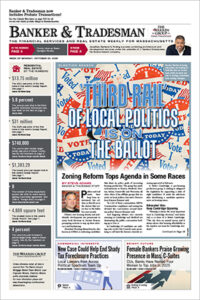For the first time in more than two years, foreclosure petitions dropped on a year-over-year basis. Petitions were down 1.1 percent from July 2015, according a report from The Warren Group, publisher of Banker & Tradesman.
Don’t get too excited – that percentage drop is equal to a mere 12 petitions, well within a standard margin of error. Still, even if that number adjusts over the next few weeks, it’s a sign starts are beginning to slow in the Bay State.
Foreclosures are a tricky subject with a long and fraught history. The term on its own recalls the dark days of the recession, when The Warren Group was tracking tens of thousands of petitions in a single quarter and neighborhoods could go dark in a matter of weeks.
Since then governments local and national have cast a very sharp spotlight on the industry and addressed a lot of injustices – but many still remain. Foreclosure petitions in Massachusetts dropped completely off a cliff in 2013 – there were as few as 200 in a month – which has warped our year-over-year comparisons ever since. Once they started to pick up again, lenders and attorneys swore on a stack of bibles that the increased activity was attributable to that lost year in 2013.
And we believed them. We still do, to a certain extent, and July’s figures help support that conclusion. One occurrence does not create a trend, and we await August’s figures with interest.
However, rarely is there only one explanation for any occurrence, and certainly not in the multifaceted housing market. As distasteful as it may be to contemplate, as long as there is human misery, there will be foreclosures. Loss is a part of life, and the loss of one’s health, spouse, income or any number of other things can result in an inability to pay the bills.
When the bills don’t get paid, the lender will seize the asset – not because they’re greedy, inhuman monsters, but because that’s the way capitalism works. (They may also be greedy, inhuman monsters; rarely is there only one explanation for an occurrence.)
So yes, some of July’s 1,032 foreclosure petitions are still left over from those dark days and from the shadowy years that came later. But some were certainly not.
Some 10 years on, there are pockets of the state that are still suffering. Home prices have not recovered. Years of earnings were lost – and today’s jobs are not what they were. These miseries and more have accumulated to strike at two very different parts of the market: foreclosures are greatly increased in the Gateway Cities and in locations full of second homes.
And unfortunately – if heartlessly – foreclosures in these locations do absolutely nothing for the middle of the market, which continues to stream along as though there never was and never will be a recession.
The reasons for the current increase in foreclosures are complicated and the conclusion uncertain, but one thing is clear: the so-called recovery has left a lot of people behind, and they may never catch up.






